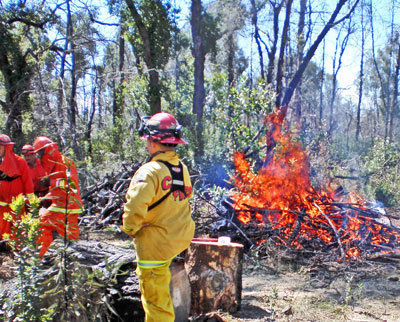
“Though nothing can bring back the hour
Of splendour in the grass, of glory in the flower;
We will grieve not, rather find
Strength in what remains behind;
In the primal sympathy
Which having been must ever be…”
— William Wordsworth
If you are like me, certain experiences in nature are forever burnished into your memories. Some of mine are Yosemite Valley, the Oak River gushing through the red rock canyons of Sedona, and scenes of our own Santa Cruz Mountains.
In the summer of 2008, the Martin Fire in Bonny Doon consumed 520 acres in five days. I remember driving through the area one evening on my way to Highway 1 and seeing the “Thank you, Cal Fire” signs that grateful neighbors had put up — even a red helicopter hovering over a lagoon close to the ocean, filling up bags of water to fight the fire.
A couple of springs later, I took a tour of the Bonny Doon Ecological Reserve with caretaker Valerie Haley. We marveled at the profusion of colorful blooms along the sand path and “fire followers” — plants, encouraged by fire, that appear where they have never been seen before.
I looked up to see statuesque, burned-out manzanitas captured in their mahogany-red skeletons against the deepest blue sky, the same hue I remembered seeing from the top of a snow-packed mountain in New Mexico several decades earlier.
“We did a shaded fuel break the year before the fire,” said Haley, who has worked at the Reserve since 1993. “We had reduced tree limbs and vegetation along Martin Road, and that bought the firefighters 15 to 20 minutes more time to fight the fire.”
A week after the fire, the botanist, who lives a mile away, saw the aftermath of the burn.
“It was a dramatic change, but I did not get upset. I did not cry. I did not freak out,” she said. “I viewed it as a natural cycle, as part of nature. I was kind of bummed, but not devastated.”
Although we fear fire, a burned landscape can create a healthier natural habitat.
“It cleans out pathogens and sterilizes the seed banks so new plants can come up,” Haley explained. “Fire cleans up the fungus, releases nutrients, cleans up duff, and allows more sunlight to come through for more biodiversity.”
A revegetation specialist at Native Vegetation Network, Haley helped save the reserve from becoming a community center several years ago by enlightening Bonny Doon residents to the unique ecological treasure they had in their own backyards.
I cannot promise you a “break-your-heart” sky, but on Saturday, May 5, Haley and I will be leading a nature walk in the reserve through an environment educational grant from the San Lorenzo Valley Water District.
In addition to “the glory in the flower,” we will follow trails through Ponderosa pine and sandstone outcroppings, also known as “moon rocks” in the mountains, which sit like giant Buddha statues on the geoscape.
– Carol Carson is a writer, naturalist, and educator. Contact her at ca****@*********on.com.











